What is PET/CT?
PET / CT (positron emission tomography / computed tomography) is considered one of the most advanced diagnostic methods.
It collects information at molecular level (e.g. via the metabolic activity of tumor foci) and converts them into images. Here, a radioactively labeled sugar compound is used (fluorodeoxyglucose, FDG), which is intensely incorporated by most malignant tumors due to the high metabolic process (see pictures). Unlike scintigraphic images, the PET has a significantly higher spatial resolution and thus a higher image quality. In addition, it is performed along with the computed tomography (CT) to combine the advantages of both imaging technologies (PET and CT). The combination of PET and CT makes it possible to visualize tumors, inflammation or neurological disorders earlier, without surgical intervention and more accurately than any other method before.
Full-FDG PET / CT (whole-body)
The aim of this study is the detection of tumors and metastases by the representation of the glucose metabolism of the cells. It is used for patients with breast cancer, colorectal cancer, lung cancer, skin cancer, lung tumors, lymphomas (Hodgkin’s disease and non-Hodgkin’s lymphoma), pancreatic cancer, gastric cancer, head neck cancer, ovarian cancer, sarcoma, search for the primary tumor of a metastatic cancer with unknown primary site (so-called CUP) and many other cancer diseases.

Brain PET / CT with FDG
Brain PET / CT with FDG
This examination allows detection of dementia diseases, such as Alzheimer’s disease at an early stage. The presentation of morbid areas is also possible in cases of focal epilepsy.
What must be done before FDG-PET / CT (Full / brain)?
You should not eat for at least 6 hours before the examination. This includes all food and beverages that are sugary or contain sugar substitutes. Drinking pure water or coffee / tea without sugar, milk and sweeteners is permitted. Patients with diabetes should not use any diabetes drug such as insulin or metformin on examination day. Other medications may be taken. For the PET / CT a blood glucose of less than 150mg / dL is optimal. At higher values the nuclear medicine physician decides under which circumstances the examination is performed. If required, the blood sugar is adjusted with human insulin by our team on the day of examination.
Examination procedure
Please allow about 2 hours for your stay with us
- A small amount of a weak radioactively labeled substance is injected into an arm vein
- After that there is a rest period of one hour
- Then the recordings are done (about 15-30 min)
The test material is specifically prepared for each patient and is very expensive . Therefore we ask for early notification in case you cannot perceive your appointment (not later than the day before until 17:00 clock). Many thanks! Our medical team has many years of PET / CT experience through activities at the University Medical Center Freiburg, the University Hospital Heidelberg, the German Cancer Research Center (DKFZ ) and the National Center for Tumor Diseases in Heidelberg .
For questions our staff and physicians are at your disposal!

PET / CT device

Early detection of a small tumor in the intestine. It was spotted early enough during a routine examination with PET

Manifestations of a lymph gland cancer before and after therapy (PET/CT)

Lung metastasis in colorectal cancer (PET with high-resolution CT)
